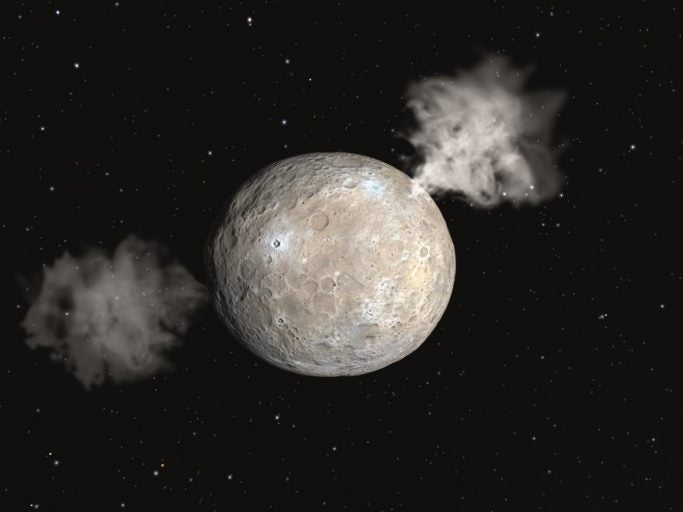In a case of fact imitating fiction, European scientists have discovered water vapor on Ceres, the largest asteroid in our solar system and they suggest volcanoes are the source.
Today, the journal Nature published an article by Küppers et al online, which documented the first direct observations of water vapor escaping from the surface of and surrounding the asteroid Ceres.
“Looks like ‘The Little Prince’ had it right all this time,” said University of Central Florida professor Humberto Campins. “All kidding aside, the team’s research is significant because it gives us more clues as to how our solar system and Earth may have formed.”
Antoine de Saint-Exupéry, an early 20th century French writer, described the surface of a fictional asteroid in his 1943 children’s book “The Little Prince.” The asteroid, with two active volcanoes and a dormant one, was the home of the central character, The Little Prince. The book, translated into dozens of languages, is famous for its lovable story and social commentary.
Nature invited Campins to write an accompanying article in the journal that explains the potential significance of the European team’s work. Campins read “The Little Prince” as a child and he said it was one of his inspirations for pursuing astrophysics as a career. Today, Campins is an international expert on asteroids. He is a member of NASA’s OSIRIS REx mission and the European Space Agency’s MarcoPolo-R mission, which both are being designed to travel to and retrieve samples from nearby asteroids. Campins also was on the first team to find evidence of water ice on an asteroid in 2010. He teaches astrophysics at UCF and is inspiring a new generation of astronomers, including his co-author Christine Comfort, a recent UCF graduate.
Scientists have long theorized that Ceres has a lot of water. But it is only through Küppers and his colleagues’ observations with the European Space Agency’s Herschel Space Observatory that the astronomy community has its first direct evidence of water molecules around Ceres, supporting previous indirect evidence that there is water in Ceres.
Their result strengthens previous indirect observational evidence for water in this planetary body, and is particularly timely because NASA’s Dawn spacecraft will soon visit Ceres, fresh from its successful mission to another intriguing small asteroid, called Vesta, Campins said.
Information from Dawn should help with another question.
“One of the most puzzling questions about the origin and evolution of asteroids is why Ceres and Vesta, which are both located in the main asteroid belt, are so different,” Comfort said.
Campins and Comfort, suggest one possible answer in their paper.
“Most likely Ceres formed in a colder, outer region of the nascent solar system than Vesta did, beyond the snow line — the distance from the young sun at which temperatures were low enough for water to condense into ice. But this hypothesis raises the question of why Ceres and Vesta are so close to each other at present. It has been suggested that soon after the formation of the asteroids and the planets there was mixing of material from the inner and outer regions of our solar system. This mixing was caused by the orbital migration of Jupiter and the other giant planets from their initial positions to where we see them today. This migration and mixing could have moved Ceres and Vesta from very distant original formation sites to their current locations. ”
This is the same theory that suggests that asteroids rich in water and organic material may have brought Earth its first building blocks for life.
“We’re not done with the puzzle yet,” Campins said. “We are learning a lot and more is likely to be discovered through further studies of the miniature worlds we call asteroids.”
